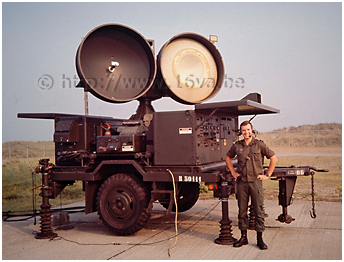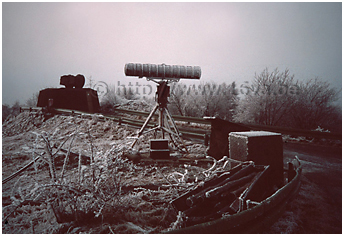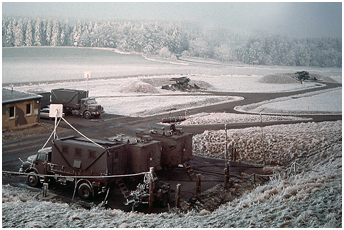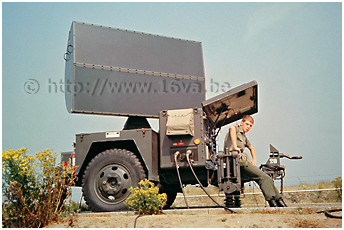
Technical means in 1990
MissileMIM-23B 'Improved HAWK'
Weight: 635kg
Range: ±45km
Ceiling: ±18km
Speed: ±Mach 2,4
Lethal area of destruction: ±180m (600 feet)
 Le radar à impulsions PAR. © L.Schmitz.
Le radar à impulsions PAR. © L.Schmitz.
The Pulse Acquisition Radar (PAR). © L.Schmitz.
PAR detection radar (Pulse Acquisition Radar)
Range: >120km
Pulse operation. This radar had a ‘Moving Target Indicator’ electronic filter to avoid false echoes caused by the environment.
While the long range detection was performing efficiently, the ‘Ground Clutter’ (electronic noise generated by the ground) made
the detection almost impossible at a range inferior to 5km.
(Rotation speed of all the radars was synchronized at 20 rpm)
CWAR detection radar (Continuous Wave Acquisition Radar)
Operation in continuous waves (Doppler principle). The CWAR was very efficient at low and medium altitudes and could detect aircraft and helicopters flying very close to the ground. The correct interpretation of its scope display was however difficult and required intensive training. The detection of aircraft was not only made visually on the scope display, but also by listening to the audio signal. The echo was automatically materialized by the firing computer and displayed on the major consoles.
HPIR tracking radar (High Power Illumination Radar)
Range: >80km
Quantity: 2 (one per firing section)
 Le "High-Power" peut suivre ses cibles à plus de 80km. L'équipement à la finition typique des années 60 a
en fait été mis à jour et cache désormais une électronique digitale moderne.
En contrôlant manuellement l'élévation et le site du radar, une équipe entraînée pouvait s'en servir comme d'un
radar de recherche. © L.Schmitz.
Le "High-Power" peut suivre ses cibles à plus de 80km. L'équipement à la finition typique des années 60 a
en fait été mis à jour et cache désormais une électronique digitale moderne.
En contrôlant manuellement l'élévation et le site du radar, une équipe entraînée pouvait s'en servir comme d'un
radar de recherche. © L.Schmitz.
The 'High-Power' can track its targets up to more than 80km. The old electronics have been replaced by modern digital
equipments. By manually controlling the elevation and the radar site, a trained team could use it as a
search radar. © L.Schmitz.
Operation in continuous waves (Doppler principle). The High Power did not turn like a search radar, but was pointed directly at
the target to illuminate it, like a spotlight. The detection was done on a small screen which displayed the speed of the target.
The echo was automatically materialized by the firing computer on the major consoles. The HPIR also generated an audio signal
to identify the target. A good operator could make the difference between a jet or a propeller aircraft, a missile or a helicopter.
The best could even count the number of engines! Engagement principle: ‘one lock, one kill’ (each HPIR engaged one target).
All radars emit harmful electromagnetic waves, but because it was not running continuously, the HPIR was particularly dangerous.
Its radiation caused severe burns up to more than 100 meters, like a giant microwave oven. The most affected tissues were the
eyes, reproductive organs and the nervous system.
IFF
 L'antenne IFF par -20°... © L.Schmitz.
L'antenne IFF par -20°... © L.Schmitz.
The IFF antenna by -20°C... © L.Schmitz.
The IFF (Identification Friend or Foe) was not a traditional radar, but rather a radio transceiver/receiver. It helped to
identify friendly aircraft by an automatic exchange of codes. Its information was presented on the main consoles by the firing
computer. In wartime it would be equipped with an encryption module in mode 4.
ROR
The ROR (Range Only Radar) was a pulse radar that was used in case of a breakdown of the ‘High Power’. Its sole function was to
determine the range of the target. This old radar was rarely used. It had never been modernized and had many failures.
BCC
The BCC (Battery Control Center) was a metal container of 3x2 meters, carried by a Magirus truck. It housed the battery firing and detection
consoles.
ICC/PCP
 The ICC (Information Coordination Center) was a metal container similar to the BCC, which housed the firing computer. Like
most hardware of the Hawk system, the computer had many ‘Hard-Wired’ (physical connection by electric cables) components to
withstand the effects of an electromagnetic pulse generated by a nuclear explosion. It treated the radar signals and generated
symbolic displays of the different targets, according to their priority. In the ‘Autofire’ mode the ICC controlled completely
the battery without human intervention (including the firing of the missiles). This mode enabled to treat a large number of
targets in the shortest time, but it was not selective. It was a last resort mode that was not used by the Belgian units.
The PCP (Platoon Command Post) was a modified version of the ICC, with a firing console. In combination with the CWAR, a HPIR
and a firing section the PCP could operate independently in the configuration ‘AFU’ (Assault Fire Unit). This ensured the
continuity of firing while moving to a new position. The AFU departed at first with a half battery. Once it was operational on the new position,
it was joined by the rest of the unit.
The ICC (Information Coordination Center) was a metal container similar to the BCC, which housed the firing computer. Like
most hardware of the Hawk system, the computer had many ‘Hard-Wired’ (physical connection by electric cables) components to
withstand the effects of an electromagnetic pulse generated by a nuclear explosion. It treated the radar signals and generated
symbolic displays of the different targets, according to their priority. In the ‘Autofire’ mode the ICC controlled completely
the battery without human intervention (including the firing of the missiles). This mode enabled to treat a large number of
targets in the shortest time, but it was not selective. It was a last resort mode that was not used by the Belgian units.
The PCP (Platoon Command Post) was a modified version of the ICC, with a firing console. In combination with the CWAR, a HPIR
and a firing section the PCP could operate independently in the configuration ‘AFU’ (Assault Fire Unit). This ensured the
continuity of firing while moving to a new position. The AFU departed at first with a half battery. Once it was operational on the new position,
it was joined by the rest of the unit.
 Principle of operation (30 seconds sequence)
Principle of operation (30 seconds sequence)
Air traffic was detected by the PAR and CWAR radars. The firing computer of the ICC processed the data and displayed it on the screens of the BCC, possibly with additional useful information such as: threat symbols, IFF data, ECM, etc. The fire officer (BCO) assigned a target to one of the two firing sections by using a joystick. The High-Power radar locked on the target and provided more accurate data. The BCO gave the order to fire: ‘Shoot One’ for a single missile or ‘Ripple Two’ for two (in the case of an attack by multiple aircraft, for example). The operator selected a launcher and started the firing sequence. The missiles were running at 2.500km per hour towards the target illuminated by the HPIR radar. After a few seconds, the rocket motor would stop and the missile would continue its interception path gliding on its impetus while being completely invisible to the pilot. It exploded when it overtook its target, destroying everything that would fly at less than 300m. The firing section could then proceed to the next target.
 |
The Hawk batteries < Part 1 > Part 3 > Part 4 > Part 5 |
 |
Plan du site - Sitemap |  |

